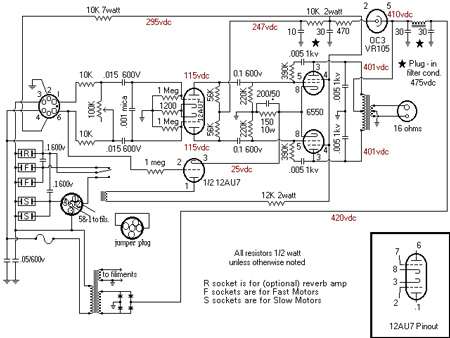LESLIE SPEAKERS
North Suburban HAMMOND ORGAN Service
The preceding is strictly a personal opinion and must be regarded as such and not as an endorsement of that method. Much of my studio electronic organ work is practice or recording, and thus these methods suit my particular needs. If I were playing a gig on a regular basis, I would invest in at least one real Leslie as the real thing is better than any reproduction if you are physically present in the same room and can listen directly to the Leslie itself, and a 31H would be really nice to have along with a 122. Oh well....!
A second 12AU7 triode in which both sections are used is the preamp that receives the balanced signal from a typical Hammond console preamplifier output [Hammond "G - G" terminals]. After that, the signal appears on the input grids of the two 6550 power pentode tubes, and from their plates, the amplified signal goes through the center-tapped primary of the output matching transformer and appears on the output plug [marked "16 ohms"]. From here, the audio signal goes to the crossover network and then everything < 800Hz goes to the 15 inch bass speaker, and everything > 800Hz goes to the treble driver.
The last thing to look at regarding Leslie speakers is a schematic of a typical Leslie power amplifier, which I have reproduced here.
The Leslie speaker in general has made an important contribution to the sound of the typical electronic organ. In the heyday of the electronic organ [1960 through perhaps 1985] just about every type of electronic organ console of any merit included a built-in Leslie speaker of some type, and every major electronic instrument dealer sold the suitable line of Leslies for use by customers who preferred either a separate speaker system apart from the console or who needed more volume to fill a large room or hall. To keep this article of manageable size and hit mainly upon the most important features of these unique speakers, we have described only the traditional Leslies that were designed to work mainly with Hammond organs. In actuality, there are many different models of Leslie speakers designed for specific makes and models of instruments. Many of these contain more conventional stationary speakers as well as rotary baffles and horns, and there are also some Leslie models in which the speakers themselves rotate.
Regardless of specific variations and extra complications, the general purpose of the Leslie, and the area in which it excels, is the production of a very rich, big, and lush-sounding vibrato/tremolo effect which can transform the sounds of even the lowliest spinet electronic to hall-filling magnificence.

Schematic of a typical 122 Leslie power amplifier. It is pretty conventional with the exception that the signal to turn the tremolo on and off is sent over the same wires that carry the audio signal from the console. This is made possible by an isolation transformer in the console, and then the tremolo signal is applied to the grid of 1/2 of a 12AU7 tube, the other half of which is not used. The tremolo/chorale mode switching relay coil is in the plate circuit of this 12AU7tube. If I had designed this, I would have used a separate wire. I have discovered that in going through the tranbsformer, the audio signal loses some bass. By eliminating this transformer and running a separate wire, I found a significant improvement in the bass response. Interesting.... I don't know if this will hold true in all installations or only certain ones but in my case, it did improve the bass significantly.
Previous Page Page 8.
Top of Page